Updated November 2020
Gmail is one of the biggest names in digital communication. With over 1.5 billion users (and counting), it absolutely dominates the way people communicate, both personally and professionally.
But despite being so popular, it can leave a lot to be desired.
Gmail, which is owned by Google, boasts an easy-to-use interface, cost-efficient (and sometimes even free, depending on your needs) plans, and integrations to make your inbox your own. However, just a few years ago, it was also the center of a scandal where Google allowed third-party apps to scan and share data from Gmail users’ inboxes.
While Gmail claims to have moved past and made user security a main priority, it still left many users with a bad taste in their mouths. And security isn’t the only issue.
Gmail for business users can feel particularly limiting. Conversation through email alone can feel clunky and outdated, and while Gmail does connect with the rest of Google’s suite of tools, the chatting and video features are pretty lackluster.
But, if you’re not going to use Gmail, what should you use? Let’s explore some alternatives.
- What is the “best” alternative to Gmail?
- The 3 best non-email alternatives to Gmail
- The 4 best email alternatives to Gmail
- How to choose the best alternative to Gmail for you
📥 Are you over email? If you hit at least one of the points on our checklist, it’s time to consider an email alternative.
What is the “best” Gmail alternative?
You’re not alone in feeling frustrated with Gmail. But unfortunately, a lot of the areas where Gmail falls flat have more to do with email as a form of communication than the platform itself.
We’ve moved beyond the days where emailing is the most efficient way to get in touch, especially with so many teams working from outside the office. As we become more and more accustomed to connecting through video calls and messaging each other to work through problems, it’s becoming increasingly apparent that email just doesn’t cut it:
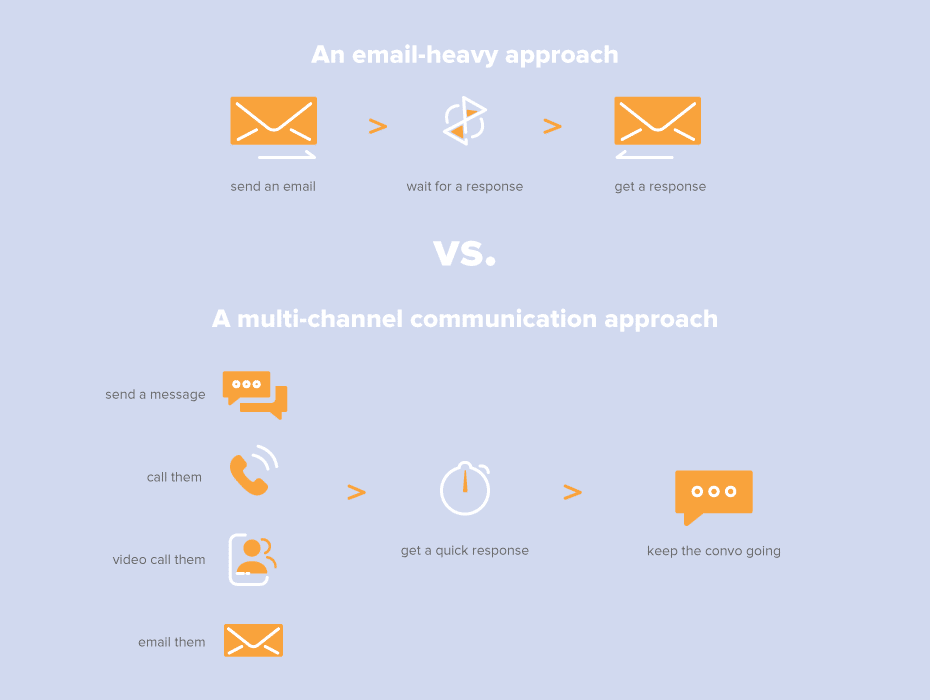
Before you start switching email providers, take a minute to think about if yet another inbox will really solve your problems.
If the answer is no, you might find that you don’t actually need a Gmail replacement—you need an entirely new way of communicating.
3 best non-email Gmail alternatives
First, let’s look at options that are not email-focused. Now, in most cases, you’ll in all likelihood still need an email address whether it’s from Gmail or Outlook or any other provider. (This is for stuff like shopping online and subscribing to email newsletters you’re interested in.) For the most part, it doesn’t look like we can do those things without an email address.
However! Beyond those use cases, the benefits of moving the majority (not all) of your communications off of email are two-fold:
- Some conversations, which are better had through other channels like a text or call, will happen more quickly and you’ll get answers to questions faster
- This leads to a less cluttered inbox because your coworkers, partners, and clients are using those different communication channels to reach you instead of making everything an email
Because of this, many of the tools in this list are as much “alternatives” to Gmail as they are complementary pieces to Gmail. If we want to imagine what a world beyond email looks like, these may very well be an important part of it.
1. RingCentral
Best for…
… teams that need other communication options like messaging, video conferencing, phone calling, and more—in one app.
Why is RingCentral a good alternative to Gmail?
For most people who are looking for “Gmail alternatives,” they’re probably just thinking of other email clients that can help them communicate better through that specific channel: email. But from what we’ve seen in recent years, most teams need a better way to communicate—beyond just email.
That’s where RingCentral comes in.
RingCentral won’t eliminate your email needs entirely. However, it can handle pretty much any other kind of communication you’ll need in one platform. To get messaging and a business phone system in the app, the most basic RingCentral Office plan will do. If you want other features too like video conferencing and unlimited users, you can look at next-level-up plans.
If you need to stay in touch with your own team, the desktop and mobile app gives you chat messaging, video conferencing, screen sharing, and even file sharing:

You can even create and assign tasks, and keep track of your to-do lists within the app:

When it comes to external communications with clients or vendors, you can make both video and traditional phone calls from the app too—and flip from one type of call to the other. Because sometimes, you just want to talk face to face:
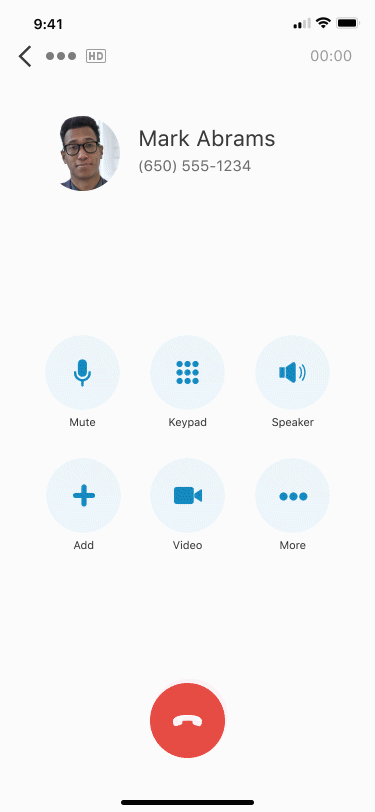
Pros:
- Lets you consolidate a bunch of tools that you might be paying for right now:
- messaging
- video conferencing
- screen sharing
- a phone service
- file sharing
- task management
- note-taking
- and there’s probably more that we missed
- Lets you handle both internal and external communication, again, in one app
- Backed by seven layers of security
Cons:
- More expensive than other tools on this list up front, but it can save you money in the long run because of its versatility—because it has messaging, video conferencing, a phone service, and more built in, it can replace a few tools (at least) that you’re already paying for.
🤯 On top of all this, RingCentral could save you up to $400 an hour in IT costs.
Explore the RingCentral Advantage for small businesses:
💰 You can also use this calculator to see roughly how much your business could save by using RingCentral to support your team’s communication with each other—and clients.
2. Asana
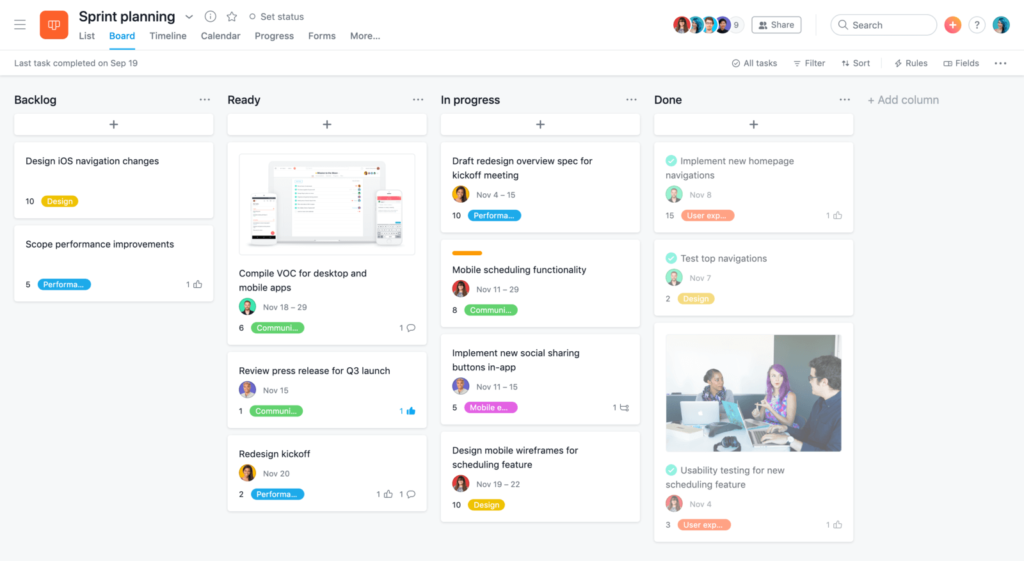
Best for…
… teams wanting to cut back on project-based emails.
What makes Asana a good alternative to Gmail?
Like RingCentral, Asana probably won’t allow you to cut back on email use entirely (it’s not meant to do that), but it can dramatically reduce the number of emails you’re sending. By using Asana in conjunction with Gmail (or one of the email alternatives we listed above), you can keep your inbox cleaner and more organized.
Asana isn’t an email platform. It’s not actually a communication platform at all. Asana is actually a project management tool, but depending on where Gmail is falling short, it’s perfectly capable of improving internal communication.
Are you using email primarily to connect with your team to get project updates or share documents? Is it creating a confusing mess?
Asana eliminates the need to use email to correspond about specific projects. Within the platform, users can share documents, make comments, and ask team members questions about the tasks they are working on. You can easily delegate items to keep things moving forward.
However, Asana is really for internal communication only. While you could add clients as external users so they can contribute or keep an eye on their projects, it’s not a viable option for day-to-day communication with people outside your organization.
Pros:
- Keep project-based communication organized
- Easily share and store relevant documents and information with your team
- Delegate tasks
Cons:
- No opportunity for general communication amongst the team
- No easy way to communicate with outside parties and clients
What makes Asana a good alternative to Gmail?
Asana probably won’t allow you to cut back on email use entirely, but it can dramatically reduce the number of emails your sending. By using Asana in conjunction with Gmail (or one of the email alternatives we listed above), you can keep your inbox cleaner and more organized.
3. Slack
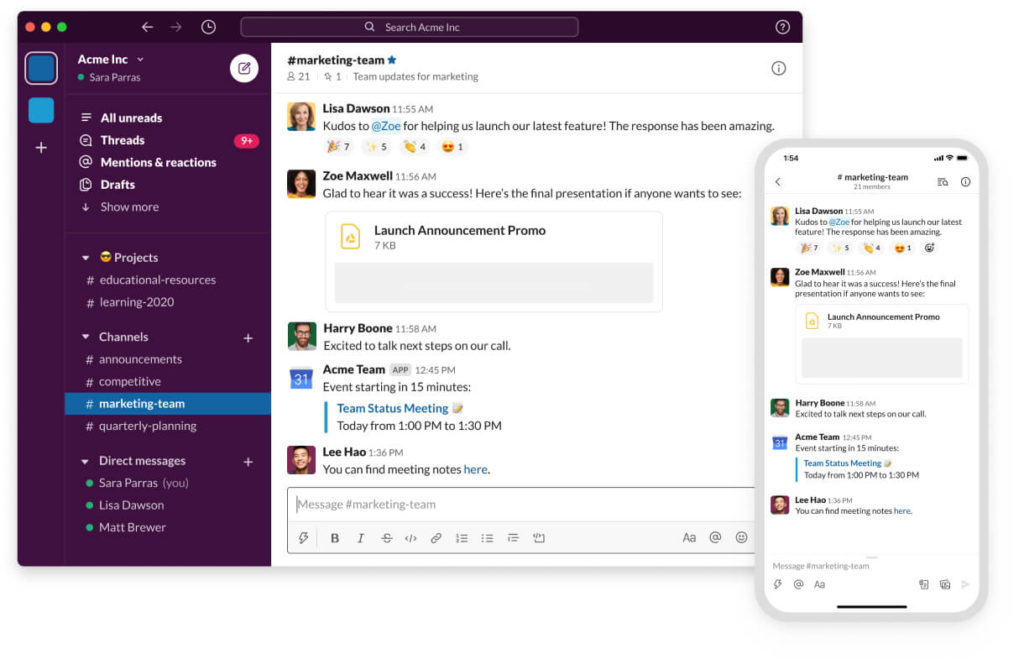
Best for…
… internal teams looking for a messaging-focused way to collaborate.
What makes Slack a good alternative to Gmail?
Slack is another communication tool used primarily for internal teams. Like Asana, Slack is able to reduce the number of emails you’re sending to team members related to projects you’re working on or documents you need to share.
However, because Slack is built for communication (not for project management), you have a lot more freedom for how and where you have those conversations.
Slack breaks communication down by channel, not by project. You can lump conversations together based on things like client, team, or you can have open channels for typical watercooler-style conversations.
Many teams choose a chat-based communication tool like Slack because it’s easier and allows for more collaborative discussions. You can easily break conversations into threads or leave them open to the entire channel without needing to worry about confusing multiple replies or someone getting dropped from the conversation.
Pros:
- Easy collaboration
- Simple document sharing
- Integrates with top apps and tools
Cons:
- Primarily internal communication only
- Video conferencing is subpar
4 best email alternatives to Gmail
While there are many better ways to communicate than through email, the reality is, we still need an email address to function in today’s society. Email is still a go-to form of communication for business and personal purposes, so even if you’re ready to ditch Gmail, you probably need an email alternative lined up.
Luckily, you have a lot of options. Here are three of the most popular and who they’re best for.
1. Outlook

Best for…
… companies that want top tech backing with more robust security features.
What makes Outlook a good alternative to Gmail?
If you’re ready to move on from Gmail but you still want the backing and support of a major tech company, Outlook is going to be your best option. However, if you’re still planning on using other Google apps (like Drive, Docs, and Sheets), you might find the lack of integration with Outlook frustrating.
Outlook tends to be Gmail’s largest competitor. Owned by Microsoft, Outlook also has the backing of a big company–meaning you’ll get a lot of features baked in. Like Gmail, Outlook (and Microsoft) also has a group of productivity tools and apps (Word, Excel, Calendar, etc.) to help your team stay on task and organized.
Pros:
- Easy to use with a clean, modern design
- Easily integrates with other Microsoft products (if you use Microsoft products)
- Secure inbox and top-of-the-line filtration system
- Simple mobile apps
- High-quality built-in features
Cons:
- A little more difficult to use with third-party integrations
- Lack of customer support
2. Tutanota
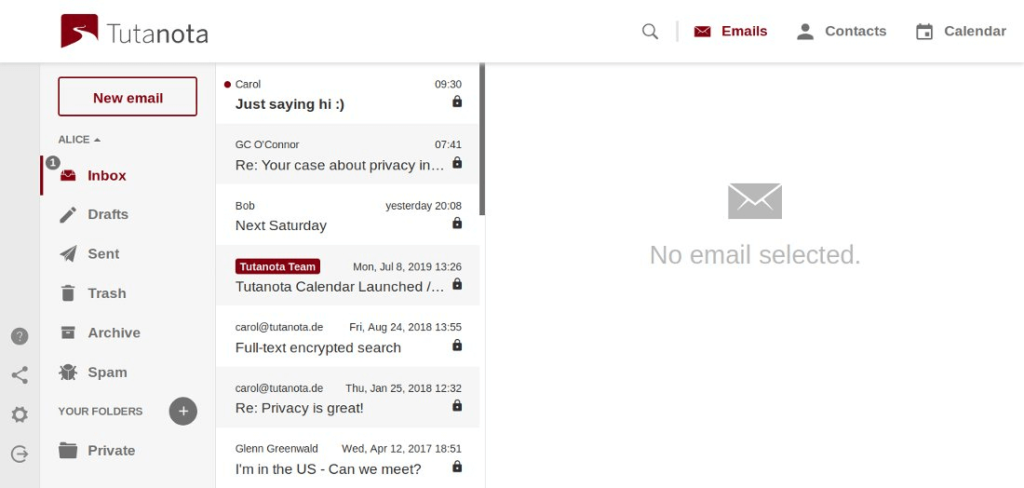
Best for…
… teams with security as a top priority.
What makes Tutanota a good alternative to Gmail?
If you’re running from Gmail due to privacy concerns, Tutanota can give you the encryption you’re looking for without expecting you to pay an arm and a leg. Although Tutanota might be a lot smaller than Gmail, it can offer a lot of the same functionality.
Tutanota’s main selling point is its security features. Although it’s not quite as large or well-known as Gmail or Outlook, Tutanota also doesn’t have a major tech company backing it—which is a pro for some people. Tutanota provides end-to-end encryption for secure messaging and even has an open-source platform that allows security experts to verify the code.
Pros:
- Advanced security features
- Mobile apps for iOS and Android
- Calendar and contact integration
- Free basic plan and premium accounts with additional features
- Comprehensive search function
Cons:
- Lack of IMAP, so limited ability to view mail in outside apps
- Minimal customer support
3. Mailbox.org
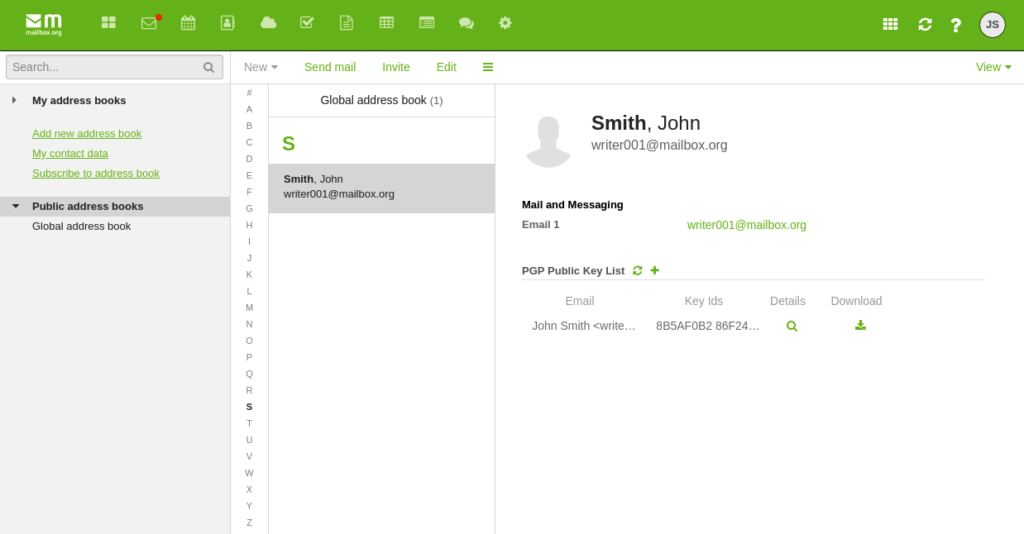
Best for…
… teams looking to move away from Gmail (and other major tech companies) completely.
What makes Mailbox.org a good alternative to Gmail?
Mailbox.org really delivers more than just an inbox experience. In addition to additional security features, it gives you alternatives for a lot of Google Workspace tools, including word processing and managing contacts. Mailbox.org also offers what they call a “personal office”—a one-stop location to check emails, manage files, and even check in on social media accounts or RSS feeds.
Mailbox.org is a Germany-based business offering low-cost and ad-free email accounts and inboxes that are both user-friendly and professional. Because Mailbox.org is based in the EU, it complies with EU data privacy regulations, which at this time are stricter than those in the US. For those concerned with privacy issues, Mailbox.org is a great alternative.
Pros:
- Plans beginning at just €1 a month
- Full-text search
- Self-learning tabbed inbox
- Calendar, task planner, and word processing included in all plans
Cons:
- No mobile apps
4. Spark
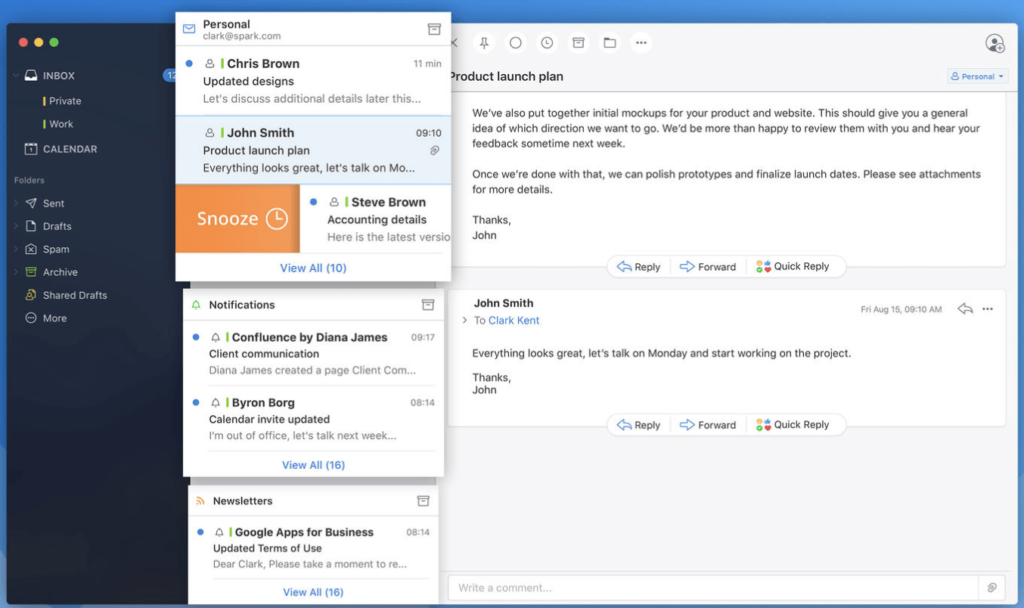
Best for…
… teams that want a new inbox without changing their address.
What makes Spark a good alternative to Gmail?
Gmail doesn’t offer its own desktop app, so if that’s something important to you, Spark is a great option. The number of features for the free tool also helps you manage your inbox and keep control of your messages.
If security issues aren’t your concern and you’re looking for an alternative that allows you to take control of your inbox, consider Spark. Spark lets you keep your Gmail email address while giving you an inbox that meets your changing needs. With Spark, you can make the most of features like follow-up reminders and quick replies, and if you have a premium Spark for Teams account, you can even collaborate with team members right from your inbox.
Pros:
- Smart inbox that automatically categorizes what is important
- Snooze emails to handle at a later date
- Team tools, like shared draft, private comments, and email delegation
- Keep your Gmail address
Cons:
- Less-than-stellar privacy policy
How to choose the best alternative to Gmail for you
There isn’t a clear answer for cutting ties with Gmail. The alternative that you choose will ultimately depend on what unique needs your team has, including what is in your budget, where Gmail is falling short, and who you hope to communicate with for each tool.
But before you jump to swap Gmail for another email alternative likely to give you the same challenges, think about the communication issues you’re really facing. Here are some things to consider:
- Are my challenges unique to Gmail? If you’re happy with using email for communication, but you’re looking for something with a little more security, you might be able to find that in an alternative. However, if your challenges are with email (and not Gmail specifically) a non-email alternative is probably a better solution.
- Do I need to communicate internally or externally? Or both? Are your primary communication challenges within your own team, or with your customers? The solution you select should focus on communication with one or the other (or, if both if that’s your challenge).
- Where do I want to invest? The tools on this list all come at different prices, and while some are lower than others, others might have more features and benefits to make that investment worth it. While it’s important to be aware of your budget, going for the free or cheapest option isn’t always the best option.
If you’re still not sure what is right for you and your team, try out a few through a free trial. The more you play around with different apps and tools, the better you can understand what features and solutions you really need.
Originally published Nov 19, 2020, updated Jun 19, 2024





